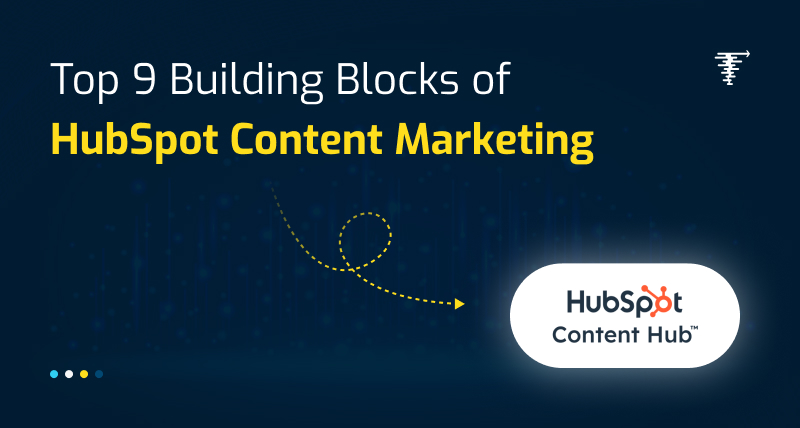

A periodic table of content marketing is a visual representation of the key elements and strategies that make up a successful content marketing campaign. HubSpot is the top Customer Relationship Management or CRM platform that enables marketers to streamline most of their content marketing tasks. A study by Content Marketing Institute (CMI) reveals that 73% of B2B marketers and 70% of B2C marketers use content marketing as part of their overall marketing strategy.
Content marketing can serve as a guide or a blueprint for developing a comprehensive and effective content strategy. By breaking down its various components into specific elements, marketers can gain a better understanding of how to create, distribute, communicate, collaborate, and optimise their content.
A periodic table of content marketing helps you break down your strategies into small portions to help you execute them holistically. According to HubSpot State of Marketing report, 82% of marketers actively use content marketing to solve their customer’s pain points and generate more leads.
The periodic table of contents can boost your business growth if you understand the right usage and implementation of all the elements in the table of content marketing plan in the right way.
Let's explore the factors of a periodic table of content marketing and how they can contribute to business growth based on current trends and best practices:
Following the HubSpot state of marketing report, 48% of companies that have a B2B content strategy in place can leverage blogging for prospect conversion at a fast pace.
The foundation of any successful content marketing campaign is a well-defined strategy, including goals, target audience, content formats and distribution channels.
Not only this, but you can see this entire process from the initial stage to what customers give you. The periodic table can help you break down the blog strategy even further and give you a complete view of where it can be published, distributed, shared, and repurposed and how it is expected to fare – all under one single roof.
Related Blog: How AI Shaping the Future of Content Optimization and Writing
Putting random content may lead to inappropriate traffic on your website, leading to decreased domain authority. This is where you decide the best content format to be the most engaging content asset for your customers. Being aware of and implementing a captivating format can set your brand voice according to the clientele.
A periodic table of content marketing can enable you to break down the various formats to use your content in different formats (blog, video, infographic, social media, Ebook, Eguide, whitepaper, case study) and decide which one will fetch the best results.
Do more with less! You suddenly realise that you have already generated excess content and there is nothing more to be covered. During such instances, the best thing to do is to prepare a content marketing strategy and repurpose or reuse the existing content.
If you have similar blogs around one topic, then you can create an E-book or e-guide! Is a blog worthy of becoming a video? Do that!
Curating a fresh new copy takes more time in collating factual data and hours of effort in researching to gain in-depth knowledge of a topic. However, the best way to make worth of existing content on your website is by repurposing it.

Channel distribution solely relies on the type of content you produce -- web content, emails, blog post, whitepapers, Ebooks and others. For instance, if you want to publish a whitepaper, then it should be published on your website.
Similarly, blog posts can be published on websites, and other platforms like Medium, LinkedIn or Quora. Want to announce that you have a new whitepaper? You can use this content as for lead generation in email marketing.
Effective digital marketing is based on having a profound understanding of your audience's needs and serving them with relevant content along their buying process. This means collecting audience insights to know their pain points and micro-moments—their questions during moments of need—and then serving them useful content, like guides, videos, or lists, at the right time. By consistently providing the SEO content marketing strategy at the right time, you earn trust and establish your brand as a trusted guide, so when the moment arises, customers will recall you.
Read Also: The Art of Content Marketing
SEO content creation generates leads by "gating" such valuable assets as templates or ebooks, asking users to give contact information to access. This not only captures the leads but also allows marketers to segment audiences, measure lead temperature, and sequence sales efforts by content engagement. Additionally, turning your content into more than just an engagement device but a powerful lead qualification vehicle.

Content marketing establishes brand positioning by showing invaluable USPs via useful, non-promotional content. This B2C and B2B content strategy includes thought leadership articles or even short expert quotes in outside publications, creates industry authority, generates organic traffic, and increases brand recognition.
SEO-optimised site content, such as keyword-driven category pages and focused blog posts, enhances search rankings. Category pages are driven by commercial keywords, whereas blogs touch micro-moments and increase engagement metrics such as time on site, eventually improving visibility.
The effectiveness of your content marketing efforts needs to be measured at regular intervals through metrics such as traffic, engagement, leads, conversions and ROI so that you are able to optimise your strategy and improve your results. Additionally, content audit is another method to list all data in one place and analyse the gaps and scope of improvement for your website.
If followed correctly, a periodic table of content marketing/elements can help you have a clear set of guidelines, framework, reference point, formats and awareness of what your audience wants. With this, you can solve the pain points of your customers.
Additionally, by leveraging the expertise of certified partners or specialists like Transfunnel can help you with the right HubSpot content marketing strategy.
If you are looking for a partner who can provide you with the right content marketing strategy, then get in touch with India’s Diamond HubSpot Solutions Partner and the FIRST HubSpot CRM implementation partner in APAC. We'll help you with the right content marketing strategy and well as SEO-friendly content that is not only identified by Google but by conversational AI.
Get Your HubSpot Content Strategy for Successive Growth. Book a Meeting